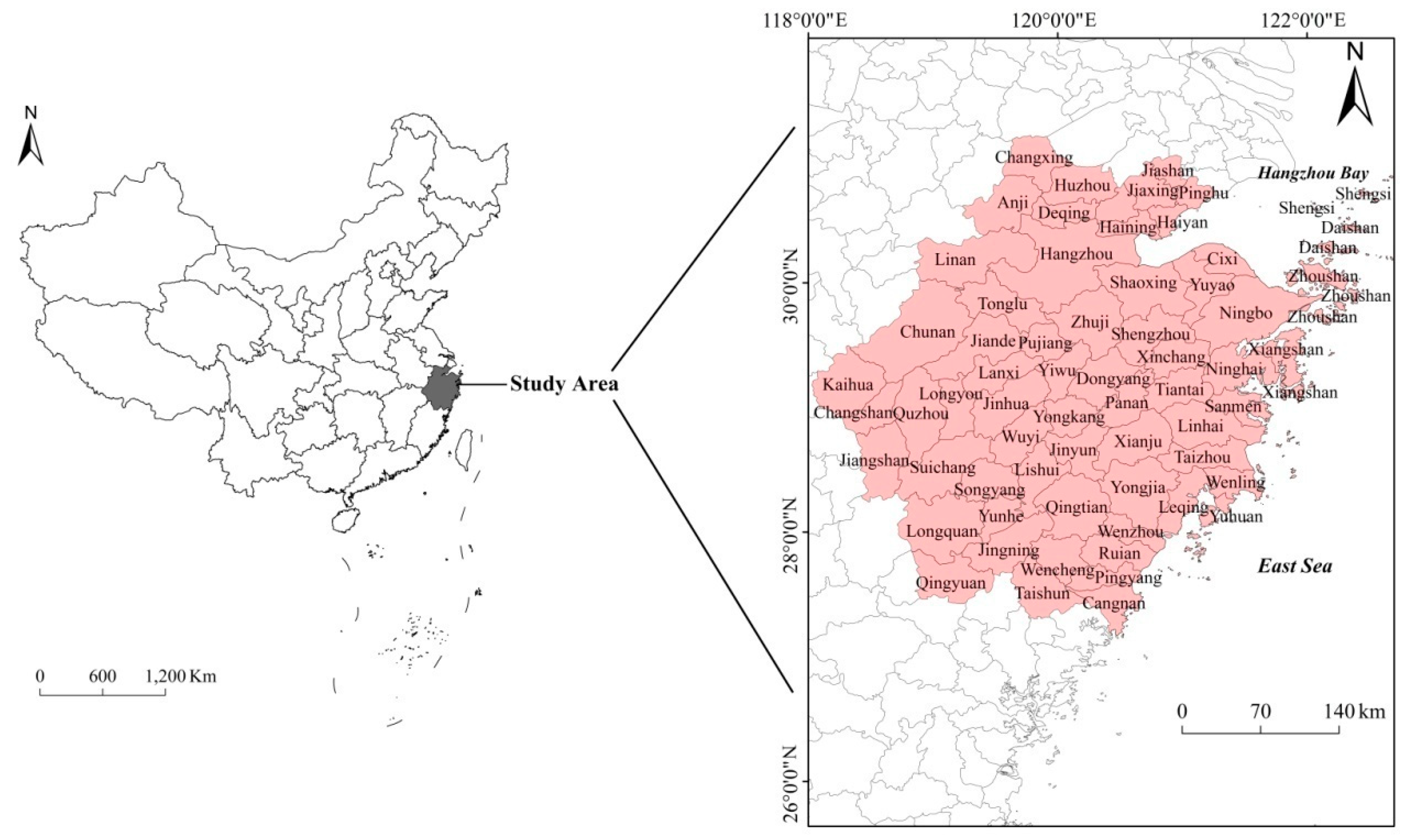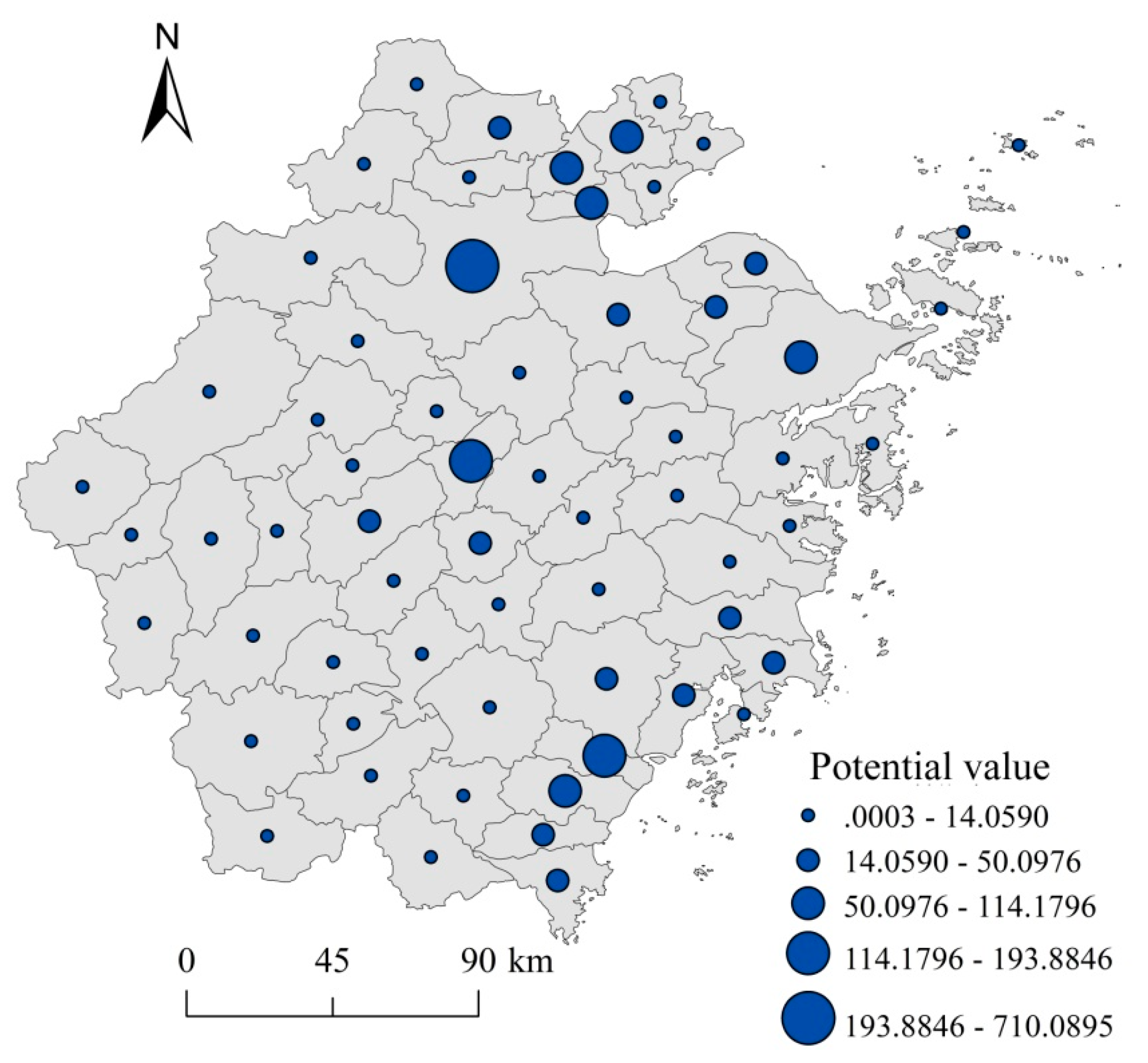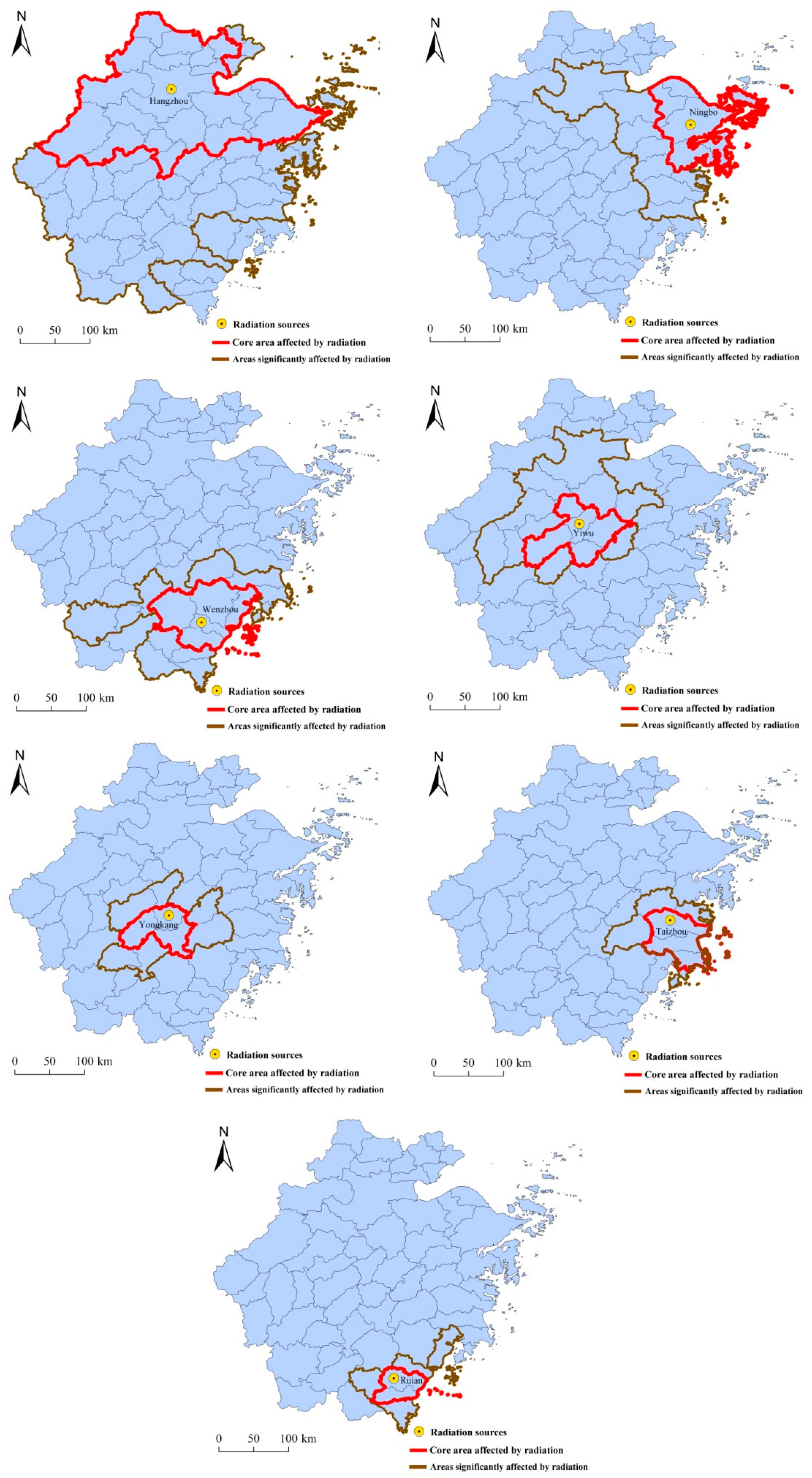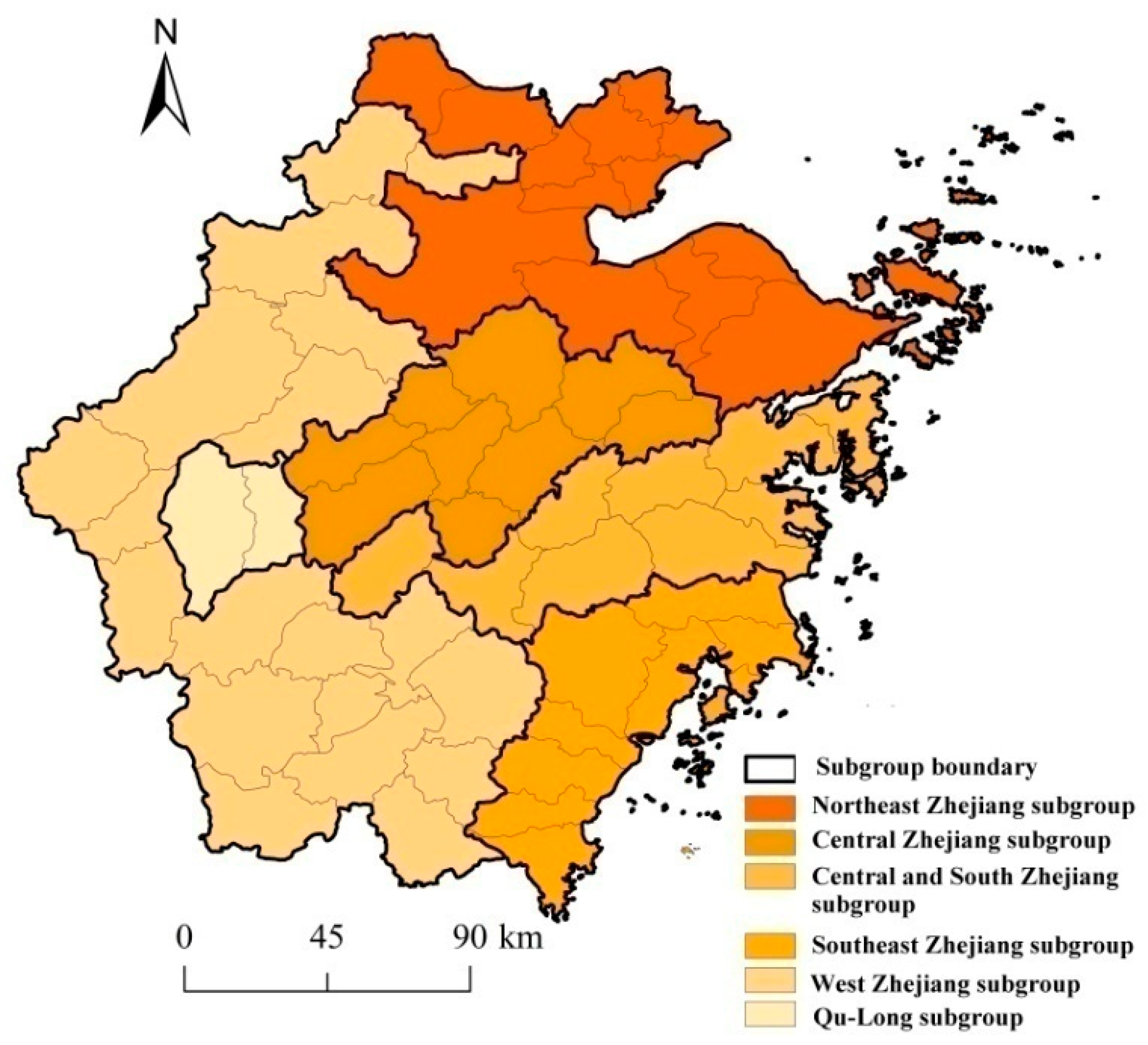Research on the Spatial Features of the E-RetailingEconomic Linkages at County Level: A Case Study for Zhejiang Province, China
Abstract
:1. Introduction
2. Literature Review
2.1. Research Theory
2.2. Research Means
2.3. Research Perspective
3. Methodology and Data Source
3.1. Methodology
3.1.1. The Gravity Model
3.1.2. Social Network Analysis
- (1)
- Network density. This refers to the ratio of the number of linking pairs in the linking network in existence to that maximum number in theory, indicating the opening degree of the linking network and the linking degree between the nodes. The larger the network intensity, the more intensive the linking network. The formula is as follows:D is the network density with a value range of (0, 1); refers to the number of effective linking pairs between network nodes and ; n is the number of network nodes.
- (2)
- Network centrality. This can be divided into absolute degree centrality and relative degree centrality, the latter usually adopted to represent network centrality. This indicator is used to measure the centrality of each node in the network based on the number of linking pairs in the regional linking network; the larger the value, the stronger the centrality of each node. The formula is as follows:Here, denotes the relative degree centrality of node , and is its absolute degree centrality, representing the number of effective network linking pairs between node and other nodes.
- (3)
- Network cohesive subgroup. The cohesive subgroup is a method to cluster the regional economic connection network according to the similarity and difference among the nodes in the complex network model, which can be measured from the reciprocity, proximity or accessibility, frequency, and closeness of the relationship among the members of the subgroup [45,46]. This method is, essentially, a clustering analysis method, which studies the overall structure features of a regional economic linkage network at the position level.
3.2. Data Sources and Processing
4. Spatial Analysis of E-Retail Economic Links at County Level in Zhejiang Province
4.1. Overall Pattern of E-Retail Economic Linkage
- (1)
- The results show that spatial polarization is prominent, and that the regional overall difference is significant. Table 1 and Figure 2 show that the urban area of Hangzhou has the highest potential (710.09), while Shengsi County has the lowest, at less than 0.01, indicating that intra-regional spatial polarization is extremely prominent. Counties and cities with a high potential are concentrated in the central and northeast part of the province, as well as the southeast costal region. These areas have a rather high variable coefficient of 2.98, and are in a highly variable state.
- (2)
- The east-west gradient difference is remarkable. In line with Zhejiang’s economic development and regional characteristics, and with reference to relevant geographical zoning standards [47], the province was divided into four areas—Northeast Zhejiang (Hangzhou, Ningbo, Jiaxing, Huzhou, Shaoxing, and Zhoushan), South Zhejiang (Wenzhou and Taizhou), Central Zhejiang (Jinhua), and Southwest Zhejiang (Quzhou and Lishui)—so as to comparatively analyze the spatial differences in Zhejiang’s e-retaileconomic linkages at this level. From the perspective of the east-west difference of the potential, Table 2 shows that the total potential of the economic development of e-retail in Northeast Zhejiang is 1269.4, which is 2.72 times that of South Zhejiang, 4.65 times that of Central Zhejiang, and 68.11 times that of Southwest Zhejiang. The variable coefficients of Northeast Zhejiang, South Zhejiang, Central Zhejiang and Southwest Zhejiang are 4.3, 1.6, 1.68, and 1.13, respectively, suggesting that Northeast Zhejiang’s link with the external economy is the strongest, followed by Central Zhejiang and South Zhejiang, and that of Southwest Zhejiang is the weakest.A remarkable east-west gradient developmental difference was observed. From the viewpoint of the east-west differences in regional linkage, the link between Northeast Zhejiang and Central Zhejiang is the highest, with a linking degree of 297.09, followed by that between South Zhejiang and Northeast Zhejiang. Overall, there is a clear east-west gradient difference between the four areas of Zhejiang.
- (3)
- The potential of the urban areas of prefecture-level cities was found to be generally higher than that of counties and county-level cities. The average potential of the urban areas of 11 prefecture-level cities in Zhejiang was 112.57, with 27.3% of these regions having a higher potential than the average. Conversely, the average potential of counties and county-level cities was only 14.89, with 24.5% of these regions having a higher potential than the average, indicating that the urban areas of prefecture-level cities are more closely linked with the external e-retail economy. In addition, the variable coefficient of the urban areas of the 11 prefecture-level cities was 1.84, while that of counties and county-level cities was 2.01, demonstrating that the difference between the urban areas of prefecture-level cities is smaller than that between the counties and county-level cities.
4.2. Main Gravity Direction of E-Retail Economic Links
4.3. Range of E-Retail Economic Linkage
4.4. Analysis of the Cohesive Subgroup Pattern of E-Retail Economic Linkages
5. Conclusions and Discussion
Author Contributions
Funding
Conflicts of Interest
References
- Shi, K.B.; Vos, J.D.; Yang, Y.C.; Witlox, F. Does e-shopping replace shopping trips? Empirical evidence fromChengdu, China. Trans. Res. Part A 2019, 122, 21–33. [Google Scholar]
- Visser, E.J.; Lanzendorf, M. Mobility and Accessibility Effects of B2C E-commerce:A Literature Review. Tijdschr. Econ. Soc. Geogr. 2004, 95, 189–205. [Google Scholar] [CrossRef]
- Stranahan, H.; kosiel, D. E-tail spending patterns and the importance of online store familiarity. Internet Res. 2007, 17, 421–434. [Google Scholar] [CrossRef]
- Ha, S.; Stoel, L. Online apparel retailing: Roles of e shopping quality and experiential e shopping motives. J. Serv. Manag. 2012, 23, 197–215. [Google Scholar] [CrossRef]
- Colton, D.A.; Roth, M.S.; Bearden, W.O. Drivers of international e-tail performance: The complexities of orientations and resources. J. Int. Mark. 2010, 18, 1–22. [Google Scholar] [CrossRef]
- Siddiqui, U.A.; Khan, M.S. An exploratory study on effect of demographic factors on consumer satisfaction and its determinants in e-retailing. Manag. Stud. Econ. Syst. 2017, 3, 159–171. [Google Scholar] [CrossRef]
- Park, S.O. The impact of business-to-business electronic commerce on the dynamics of metropolitan spaces. Urban Geogr. 2004, 25, 289–314. [Google Scholar] [CrossRef]
- Gorman, S.P. Where are the Web Factories: The Urban Bias of E-business Location. Tijdschr. Econ. Soc. Geogr. 2002, 93, 522–536. [Google Scholar] [CrossRef]
- Farag, S.; Krizek, K.J.; Dijst, M. E-shopping and Its Relationship with In-store Shopping: Empirical Evidence from the Netherlands and the U.S. Transp. Rev. 2006, 26, 43–61. [Google Scholar] [CrossRef]
- Farag, S.; Schwanen, T.; Dijst, M. Empirical Investigation of Online Searching and Buying and Their Relationship to Shopping Trips. Transp. Res. Rec. 2005, 1926, 242–251. [Google Scholar] [CrossRef]
- Anderson, W.P.; Chatterjee, L.; Lakshmanan, T.R. E-commerce, Transportation, and Economic Geography. Growth Chang. 2003, 34, 415–432. [Google Scholar] [CrossRef]
- Weltevreden, J.W.J.; Rotem-Mindali, O. Mobility effects of b2c and c2c E-commerce in the Netherlands: A Quantitative Assessment. J. Transp. Geogr. 2009, 17, 83–92. [Google Scholar] [CrossRef]
- Huang, Y.; Zhen, F.; Wang, X. Spatial Organization and Expansion of Economical Chainstore Hotel under the in Fluence of E-Commerce in the Main City of Nanjing as an Example. Econ. Geogr. 2012, 32, 56–62. [Google Scholar]
- Shi, K.B.; Yang, Y.C.; Yang, X.A.; Bai, S.; Shao, R.; Li, B. Does time dictate the location of e-commerce business?A study of O2O businesses in Chengdu, China. Acta Geogr. Sin. 2016, 71, 500–514. [Google Scholar]
- Shi, K.B.; Yang, Y.C.; Bai, S.; Li, E.L.; Chen, D. Innovation diffusion hypothesis or efficiency hypothesis: Spatial penetration of online-to-offline e-commerce in China based on Meituan.com. Geogr. Res. 2018, 37, 83–796. [Google Scholar]
- Haythornthwaite, C. Social network analysis: An approach and technique for the study of information exchange. Libr. Inf. Sci. Res. 1996, 18, 323–342. [Google Scholar] [CrossRef]
- Yang, L.H.; Liu, N.; Bai, C.L. The Spatial Structure of the Tourism Economy in Beijing-Tianjin-Hebei-Xiongan Region. Sci. Geogr. Sin. 2018, 38, 394–401. [Google Scholar]
- Sun, Q.; Tang, F.H.; Tang, Y. An economic tie networkstructure analysis of urban agglomeration in the middle reaches of Changjiang River based on SNA. J. Geogr. Sci. 2015, 25, 739–755. [Google Scholar] [CrossRef]
- Glückler, J. Economic geography and the evolution of networks. J. Econ. Geogr. 2007, 7, 619–634. [Google Scholar] [CrossRef] [Green Version]
- Zhong, Y.X.; Feng, X.H.; Wen, Y.Z. The evolvement and driving mechanism of economic network structure in the Changjiang River economic zone. Sci. Geogr. Sin. 2016, 36, 10–19. [Google Scholar]
- Li, X.D. Spatial structure of the Yangtze River Delta urban network based on the pattern of listed companies network. Prog. Geogr. 2014, 33, 1587–1600. [Google Scholar]
- Wang, D.G.; Chen, T.; Lu, L. Mechanism and HSR effect of spatial structure of regional tourist flow:Case study of Beijing-Shanghai HSR in China. Acta Geogr. Sin. 2015, 70, 214–233. [Google Scholar]
- Liu, H.J.; Liu, C.M.; Sun, Y.N. Spatial Correlation network structure of energy consumption and its effect in china.China. Ind. Econ. 2015, 29, 83–95. [Google Scholar]
- Zhou, C.; Zeng, G.; Cao, X.Z. Chinese inter-city innovation networks structure and city innovation capability. Geogr. Res. 2017, 36, 1297–1308. [Google Scholar]
- Eroglu, S.A.; Machleit, K.A.; Davis, L.M. Atmospheric qualities of online retailing: A conceptual model and implications. J. Bus. Res. 2001, 54, 177–184. [Google Scholar] [CrossRef]
- Chung, K.H.; Shin, J.I.; Tang, H.T.; Dong, Q. The relationship between Internet retail attributes, Internet satisfaction and Internet loyalty. J. Trans. Foreign Lit. Econ. 2010, 15, 67–77. [Google Scholar]
- Acimovic, J.; Groaves, S.C. Mitigating Spillover in Online Retailing via Replenishment. Manuf. Serv. Oper. Manag. 2017, 19, 419–436. [Google Scholar] [CrossRef]
- Chenavaz, R.; Drouard, J.; Escobar, O.R.; Karoubi, B. Convenience pricing in online retailing: Evidence from Amazon.com. Econ. Model. 2018, 70, 127–139. [Google Scholar] [CrossRef]
- Cullinane, S. From bricks to clicks: The impact of online retailing on transport and the environment. Transp. Rev. 2009, 29, 759–774. [Google Scholar] [CrossRef]
- Yeung, G.; Ang, K.L. Online fashion retailing and retail geography: The blogshop phenomenon in Singapore. Tijdschr. Econ. Soc. Geogr. 2016, 107, 81–99. [Google Scholar] [CrossRef]
- Tolstoy, D.; Jonsson, A.; Sharma, D.D. The influence of a retail firm’s geographic scope of operations on its international online sales. Int. J. Electron. Comm. 2016, 20, 293–318. [Google Scholar] [CrossRef]
- Tamimi, N.; Rajan, M.; Sebastianelli, R. The state of online retailing. Internet Res. 2003, 13, 146–155. [Google Scholar] [CrossRef]
- Souitaris, V.; Balabanis, G. Tailoring Online retail strategies to increase customer satisfaction and loyalty. Long Range Plan. 2007, 40, 244–261. [Google Scholar] [CrossRef]
- Edwards, J.B.; Mckinnon, A.C.; Cullinnane, S.L. Comparative analysis of the carbon footprints of conventional and online retailing: A last mile perspective. Int. J. Phys. Distrib. Logist. Manag. 2010, 40, 103–123. [Google Scholar] [CrossRef]
- Shi, Y.; Yang, Z.F.; Yan, H.; Tian, X. Delivery efficiency and supplier performance evaluation in China’s E-retailing industry. J. Syst. Sci.Complex. 2017, 30, 392–410. [Google Scholar] [CrossRef]
- Ahn, T.; Ryu, S.; Han, I. The impact of Web quality and playfulness on user acceptance of online retailing. Inf. Manag. 2007, 44, 263–275. [Google Scholar] [CrossRef]
- Wang, M.F.; Lu, S. Exploring the spatial organization of online retailing:A case study of Dangdang.com. Geogr. Res. 2011, 30, 965–976. [Google Scholar]
- Griffis, S.E.; Rao, S.; Goldsby, T.J.; Niranjan, T.T. The customer consequences of returns in online retailing: An empirical analysis. J. Oper. Manag. 2012, 30, 282–294. [Google Scholar] [CrossRef]
- Subramanian, N.; Gunasekaran, J.; Yu, J.; Cheng, J.; Ning, K. Customer satisfaction and competitiveness in the Chinese E-retailing: Structural equation modeling (SEM) approach to identify the role of quality factors. Expert Syst. Appl. 2014, 40, 69–80. [Google Scholar] [CrossRef]
- Wang, M.M.; Cao, X.S. The measurement of inter-county economic linkage and spatio-temporal dynamics analysis in Guanzhong-Tianshui economic region based on the traffic accessibility. Geogr. Res. 2016, 35, 1107–1126. [Google Scholar]
- Li, S.C.; Gong, J.; Deng, Q.J.; Zhou, T.Y. Impacts of the Qinghai–Tibet railway on accessibility and economic linkage of the third pole. Sustainability 2018, 10, 3982. [Google Scholar] [CrossRef]
- Yang, W.L.; Du, D.B.; Liu, C.L.; Ma, Y.H. Study on the spatial-temporal evolution and internal mechanism of geo-economic connections of China. Acta Geogr. Sin. 2016, 71, 956–969. [Google Scholar]
- Miao, H.L.; Zhou, H.A. Comparative Analysis on Economic Linkage and Hierarchical Structure of the Top Three Urban Agglomerations in China—Using a Synthesized Gravity Model. Econ. Geogr. 2017, 37, 52–59. [Google Scholar]
- Ou, X.J.; Xue, L.P.; Gu, W.J. Characteristic in Space Economic Contacts of Cities and Counties in Jiangsu Province. Econ. Geogr. 2015, 35, 24–31. [Google Scholar]
- Liu, J. Research and analysis of social network model. Sociol. Res. 2004, 19, 1–12. [Google Scholar]
- Zou, J.L.; Liu, W.D. Trade Network of China and Countries along “Belt and Road Initiative”Areas from 2001 to 2013. Sci. Geogr. Sin. 2016, 36, 1629–1636. [Google Scholar]
- Yu, X.X.; Wu, Y.X. The system of administrative division and the development of the cities in central area of Zhejiang—A case study on the Jinhua-Yiwu relationship. Econ. Geogr. 2011, 31, 72–78. [Google Scholar]





| County | PV | County | PV | County | PV | County | PV |
|---|---|---|---|---|---|---|---|
| Hangzhou | 710.09 | Taishun | 0.12 | Jinhua | 19.23 | Taizhou | 46.43 |
| Tonglu | 2.25 | Cangnan | 21.46 | Lanxi | 4.00 | Linhai | 13.20 |
| Chunan | 0.92 | Huzhou | 23.92 | Dongyang | 12.43 | Wenling | 17.58 |
| Jiande | 1.59 | Deqing | 3.05 | Yiwu | 170.77 | Yuhuan | 1.53 |
| Linan | 2.63 | Changxing | 2.10 | Yongkang | 50.10 | Tiantai | 11.50 |
| Ningbo | 114.18 | Anji | 3.43 | Pujiang | 9.05 | Xianju | 1.13 |
| Yuyao | 18.40 | Jiaxing | 81.28 | Wuyi | 6.86 | Sanmen | 2.85 |
| Cixi | 46.24 | Jiashan | 8.52 | Panan | 0.45 | Lishui | 1.93 |
| Ninghai | 4.03 | Pinghu | 11.85 | Quzhou | 5.39 | Longquan | 0.39 |
| Xiangshan | 0.42 | Haiyan | 3.29 | Longyou | 2.14 | Qingtian | 1.46 |
| Wenzhou | 193.88 | Haining | 100.14 | Jiangshan | 1.51 | Yunhe | 0.47 |
| Leqing | 22.91 | Tongxiang | 58.78 | Changshan | 0.39 | Qingyuan | 0.20 |
| Ruian | 80.06 | Shaoxing | 41.18 | Kaihua | 0.31 | Jinyun | 3.35 |
| Yongjia | 30.85 | Zhuji | 13.23 | Zhoushan | 0.71 | Suichang | 0.37 |
| Wencheng | 0.16 | Shengzhou | 14.06 | Daishan | 0.02 | Songyang | 0.39 |
| Pingyang | 22.64 | Xinchang | 3.35 | Shengsi | 0.01 | Jingning | 0.31 |
| Area | Potential Value | Northeast Zhejiang | South Zhejiang | Central Zhejiang | Southwest Zhejiang | Variable Coefficient |
|---|---|---|---|---|---|---|
| Northeast Zhejiang | 1269.64 | - | 68.80 | 297.09 | 16.43 | 4.30 |
| South Zhejiang | 466.28 | 19.25 | - | 15.71 | 13.45 | 1.60 |
| Central Zhejiang | 272.89 | 78.73 | 14.88 | - | 6.59 | 1.68 |
| Southwest Zhejiang | 18.63 | 0.73 | 2.13 | 1.10 | - | 1.13 |
| Subgroup | 1 | 2 | 3 | 4 | 5 | 6 |
|---|---|---|---|---|---|---|
| 1 | 0.641 | 0.275 | 0.128 | 0.162 | 0.077 | 0.092 |
| 2 | 0.044 | 0.452 | 0.024 | 0.071 | 0.143 | 0.011 |
| 3 | 0.000 | 0.048 | 0.267 | 0.100 | 0.000 | 0.013 |
| 4 | 0.131 | 0.243 | 0.283 | 0.711 | 0.100 | 0.085 |
| 5 | 0.000 | 0.000 | 0.000 | 0.000 | 1.000 | 0.038 |
| 6 | 0.000 | 0.000 | 0.000 | 0.000 | 0.000 | 0.000 |
© 2019 by the authors. Licensee MDPI, Basel, Switzerland. This article is an open access article distributed under the terms and conditions of the Creative Commons Attribution (CC BY) license (http://creativecommons.org/licenses/by/4.0/).
Share and Cite
Shen, W.; Qin, Y.; Xie, Z. Research on the Spatial Features of the E-RetailingEconomic Linkages at County Level: A Case Study for Zhejiang Province, China. ISPRS Int. J. Geo-Inf. 2019, 8, 324. https://doi.org/10.3390/ijgi8080324
Shen W, Qin Y, Xie Z. Research on the Spatial Features of the E-RetailingEconomic Linkages at County Level: A Case Study for Zhejiang Province, China. ISPRS International Journal of Geo-Information. 2019; 8(8):324. https://doi.org/10.3390/ijgi8080324
Chicago/Turabian StyleShen, Wei, Yaochen Qin, and Zhixiang Xie. 2019. "Research on the Spatial Features of the E-RetailingEconomic Linkages at County Level: A Case Study for Zhejiang Province, China" ISPRS International Journal of Geo-Information 8, no. 8: 324. https://doi.org/10.3390/ijgi8080324





